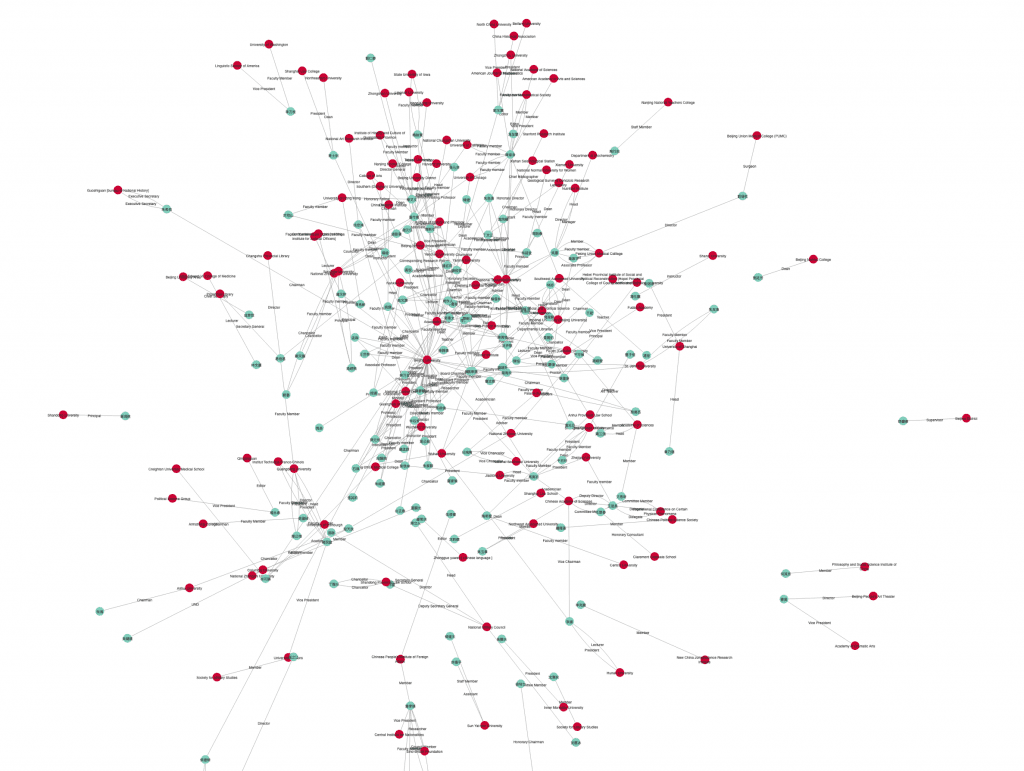
The dashboard constitutes the main gateway for a visual exploration that data extracted from the BDRC in visual form. It is made up of three categories of data:

We implemented a systematic mapping of relations of all the individuals whose name appears in the BDRC. Our goal was to reveal and qualify the relations that existed within the group of historical figures, including both the biographed characters and the individuals mentioned in their biographies. All the networks are based on word occurrences — mention of a named entity — in the text, except for the network built on a set of 36 annotated biographies. Our ultimate goal was to reconstruct the networks of social relations from texts and to provide an alternative, non-linear reading of the BDRC. This section provides a gateway to all the networks we found relevant to produce in the course of our analysis. They are available as interactive networks on the NDEx platform. A search in the "Network name" column will return the networks that contain "BDRC" in their title. A search in the general search window of NDEx (Magnifier icon) will return all the BDRC networks.

The BDRC contains a lot of spatial data related to individuals, events, or institutions. We present here only the data related to the places of birth and death of the 589 figures in the dictionary, as well as their place of college education in China and abroad. Each topic includes a set of maps with a different focus. To visualize a map (or several at the same time), just click on the checkbox in the left-hand side vertical menu.
For births and deaths, we built for each a map of the individual locations and a map with the total number of births and deaths in each location. The destiny of most individuals took them to many places in the course of their life and very few died close to where they were born. But in the case of the individuals in the BDRC, there was both a fairly common phenomenon of concentration of deaths in the main Chinese cities, especially Beijing and Shanghai, and a very unusual phenomenon of deaths outside of China. In the former case, this attests to the social, professional, and political success of these historical figures. They completed their career in positions of power or responsibility in central institutions. In the latter case, this points to the process of migration of a segment of the elites after 1949, to Taiwan or to foreign countries (mostly the United States).
The vast majority of the individuals in the BDRC received a post-secondary education in China and/or abroad. More than fifty of them even received a Ph.D. degree. While it is impossible to retrieve any actual and usable information on their primary education, the BDRC provides at least some limited information on secondary education. College education is much more accurately surveyed in the biographies, with details on the places of education, the name of the institutions, the field of study, and the degree(s) obtained.

Mind Maps
Mind maps are one of the privileged tools that we use to design a process or to conceptualize an operation. We propose here some examples of what we produced in the course of working on the BDRC
X-Boorman plan: this mind map presents the transformation process that we designed to go from the printed version of the Biographical Dictionary of Republican China (BDRC) to X-Boorman, the enhanced online version of the BDRC.
BDRC Positions MCA: this set of mind maps was designed by Cécile Armand to prepare the task of multi correspondence analysis (MCA) that we implemented on the positions data in the BDRC. The four maps present the different levels of analysis — distant, close, case studies, politics — the various types of variables that we incorporated in the analysis and how we operated to organize different ways to associate the variables.